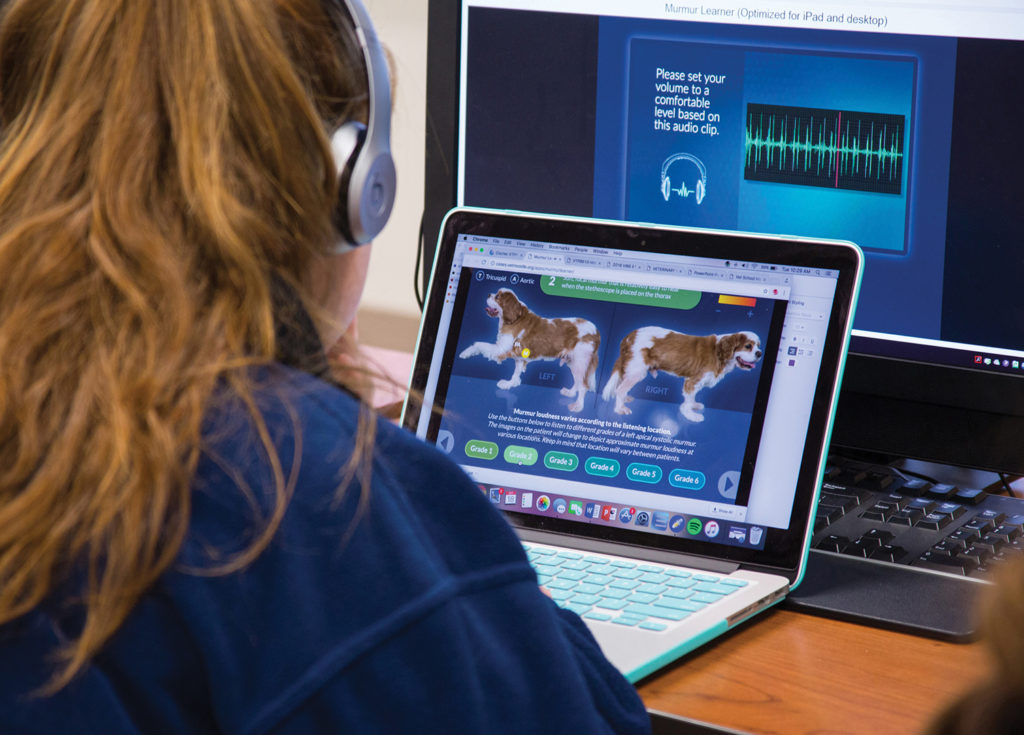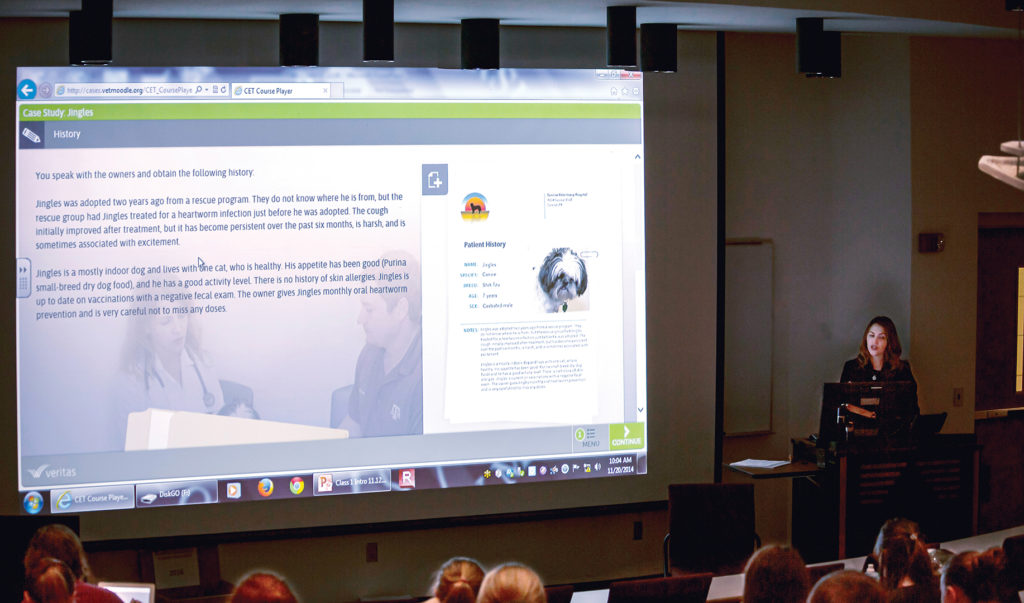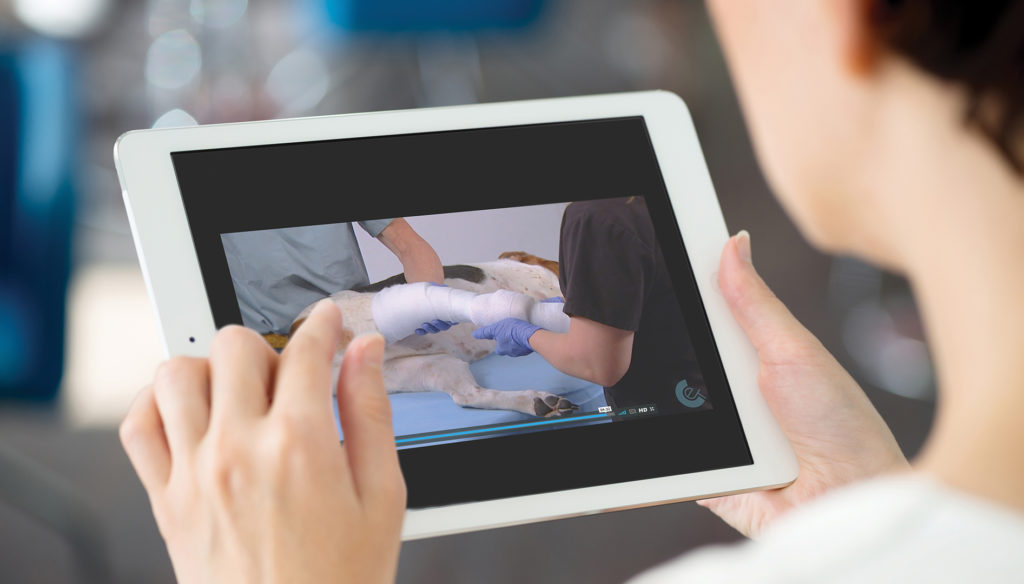ImmersED
Story by Jennifer Gauntt, CVMBS Communications
Faculty and staff at the Texas A&M Center for Educational Technologies work to enhance the Doctor of Veterinary Medicine curriculum through active-learning activities that draw from actual Small Animal Hospital cases.

More than 140 Texas A&M College of Veterinary Medicine & Biomedical Sciences (CVM) Doctor of Veterinary Medicine (DVM) students sit in groups in a classroom as cardiology professor Dr. Ashley Saunders displays a case study on a large screen.
A dog comes into a clinic exhibiting coughing issues. After Saunders presents the dog’s history, students pull up on their individual screens laboratory tests that were run.
What will they do next?
As each team types in their thoughts, Saunders can pull up a live report on her own device and see how her teams are responding, in real time.
“By seeing students’ line of thinking, Dr. Saunders can more easily respond to misconceptions or misunderstandings and see if there is a need for further discussion on a topic,” said Molly Gonzales, instructional assistant professor at the Center for Educational Technologies (CET). “If there are some groups that respond in an unexpected way, she can turn the conversation to discuss what was missed, what could be considered, or why that might not have been the best course of treatment. She’s actively walking through the clinical process with them.
“Through these clinical simulations, students can test their knowledge and understanding in a low-risk environment, where the only consequence for making a mistake is the opportunity to learn,” she said.
This kind of exercise is indicative of the way the CET harnesses technology and the diverse expertise of faculty in the Small Animal Hospital (SAH) to create learning experiences for students (both here and across the country) that enhance critical thinking, engage active learning, and strive to establish more confident veterinary graduates.
Housed within the CVM since 2011, the CET has been supporting the creation of e-learning materials and tools that offer an innovative way for rethinking how professors deliver content and how students acquire knowledge.

Other examples include the creation of videos that show students how to perform procedures on life-like models, using GoPro cameras to observe students as they perform procedures, and developing online activities that allow students to hone their knowledge of foundational veterinary skills, such as identifying teeth in a variety of species.
“The CVM is home to hundreds of faculty and staff who dedicate their time to create an environment where a lifelong love of learning and passion for veterinary medicine are the norm,” Gonzales said. “With new research and technology constantly advancing the field of veterinary medicine, the college recognizes the importance of having a dynamic curriculum with immersive learning experiences that address the needs and challenges of the current veterinary landscape.”
The CET-created resources offer many advantages for DVM students; in addition to stemming from real hospital cases, these resources integrate across the new DVM curriculum, which allows students to better apply materials learned in their first year into their second and third years, so that when they experience similar scenarios in their fourth-year clinical rotations, they can more readily associate what they’re seeing with what they learned in the classroom.
Another advantage is that students can control the pace of their own education through individualized learning tools that can be accessed at any time.
“Modules are designed so the students can control their own education by getting involved and making decisions on their own,” said Dr. Jordan Tayce, CET instructional assistant professor. “For example, with our adaptive case studies, students go through a series of scenarios and their performance dictates the next case that is unlocked, so if a student needs more practice, they have the opportunity to do so, but if the student excels, then fantastic, they could move on to the next thing.”
These tools have become so valued at Texas A&M that faculty at more than half of the veterinary schools across the country also license them to augment their own curricula; in addition, the CET has made some of its 170 educational resources available for continuing education purposes through partnerships with VetFolio and Texas A&M’s Continuing & Professional Education (CPED) platform.

“There are not a lot of other veterinary schools that have units like ours,” Tayce said. “Veterinarians are not trained to teach; they’re trained to be veterinarians. We offer that lens of the teaching perspective for faculty and for students. We offer students the opportunity to learn and think in ways that are different from the ‘traditional’ way of learning. What we’re doing is research based and it works in practice.”
Importantly, these resources also align with the new Association of American Veterinary Medical Colleges (AAVMC) Competency-Based Veterinary Education (CBVE) Framework. The CBVE has challenged veterinary schools across the country to reassess whether their traditional teaching methods were preparing future generations to be practice-ready and if those methods truly equipped students with the necessary tools to deliver care across different clinical environments.
“This call to action from the association affirmed the need for the continued use and future development of immersive learning experiences that engage learners in critically thinking through a problem and making informed decisions that lead to the appropriate diagnosis and course of treatment for patients,” Gonzales said. “This call also challenged us to see how we can provide immersive learning experiences to our former students and practicing veterinarians.”
Luckily, for both practicing and budding veterinarians, the CET is here to answer that call.
To access the catalog of CPED courses, visit https://tx.ag/CETCPED and to learn more about the Center for Educational Technologies, visit http://www.tamucet.org.


